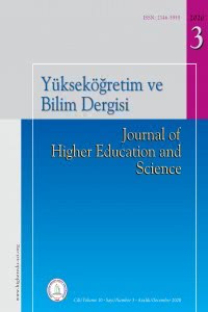Yükseköğretimde Uluslararasılaşma: En Çok Öğrenci Alan Ülkeler ve Türkiye Perspektifinden 1999-2013 Yıllarına Bakış
Yükseköğretimde uluslararasılaşmanın en önemli konularından birisi de uluslararası öğrenci hareketliliği olup 1980’lerden itibaren tüm dünyada ülkelerin ve yükseköğretim kurumlarının üzerinde odaklandığı ve politikalar geliştirdiği bir alan haline dönüşmüştür. UNESCO 2016 uluslararası öğrenci hareketliliği verileri göstermektedir ki son onbeş yılda dünya ülkelerine yükseköğretimde eğitim amaçlı giden uluslararası öğrenci sayısı iki katına çıkarak dört milyonu geçmiştir. Artan öğrenci hareketliliği ve hareketliliğin ekonomik getirisi bu alanda rekabeti arttırırken, Türkiye’nin bu alandaki konumunu ve yıllar içerisindeki gidişatını sorgulamayı gerektirmektedir. Bu çalışmada Türkiye ile birlikte dünya genelinde en çok yabancı öğrenci alan ülkeler ve bu ülkelerin uluslararası öğrenci profilindeki değişim 1999 ile 2013 yılları arasındaki verilere dayanarak değerlendirilmektedir. Hem dünya ülkeleri hem de Türkiye ölçeğinde uluslararası öğrenci akışı motiflerinin gelen öğrenci sayıları ve geldikleri dünya bölgelerine göre zaman içerisinde değişim gösterdiği tespit edilirken, bu çalışmanın bulgularının Türkiye’nin uluslararası yükseköğretim politikalarına ışık tutması beklenmektedir
Anahtar Kelimeler:
Uluslararası eğitim, Yükseköğretim, Uluslararasılaşma, Öğrenci hareketliliğ
Internationalization in Higher Education: A Look at the Years 1999-2013 from the Perspectives of the Countries with the Most International Students and Turkey
As one of the most important topics of internationalization in higher education, international student mobility has turned into an area which countries and higher education institutions from all over the world have been focusing on and developing policies since 1980s. Data on international student mobility from UNESCO 2016 show that the number of outgoing international students all over the world has been more than four million doubling in the last fifteen years. While the increase in student mobility and the economic return of such activities increase the competition in this area, this also requires questioning both the position and the trends of Turkey over the years. In this study, the world countries with the highest inflow of international students along with Turkey and the change in their international student profiles are evaluated based on the available data between 1999 and 2013. The findings indicate a change over time in the patterns of international student flow with respect to the number of incoming students and the regions of their home countries both for world countries and Turkey. These findings are expected to shed light on the Turkish higher education policies on internationalization
___
- Adams, T. & de Wit, H. (2010). Global Competition in Higher Education, a Comparative Study of Policies, Rationales and Practices in Australia and Europe. In Portnoi L. M., Rust V. D., & Bagley S. S. (Eds.), Higher Education, Policy, and the Global Competition Phenomenon (pp 219-234). New York, USA: Palgrave Macmillan.
- Aigner, J. S., Nelson, P., & Stimpfl, J. (1992). Internationalizing the university: Making it work. Springfield, VA: CBIS Federal.
- Altbach, P. G. (1998). Comparative Higher Education: Knowledge, the University, and Development. Hong Kong: Comparative Education Research Centre, The University of Hong Kong.
- Altbach, P. G. (2004). Higher education crosses borders. Change, 36(2), 18–24.
- Altbach, P. G. (2005). Globalization and the University: Myths and Realities in an Unequal World. The NEA 2005 Almanac of Higher Education. Retrieved from http://www.nea.org/assets/ img/PubAlmanac/ALM_05_06.pdf
- Altbach, P. G. & Knight, J. (2007). The Internationalization of Higher Education: Motivations and Realities. Journal of Studies in Inter- national Education, 11(3-4), 290–305. Retrieved from http:// journals.sagepub.com/doi/pdf/10.1177/1028315307303542
- ISSN: 2146-5959
- Yayın Aralığı: Yılda 3 Sayı
- Başlangıç: 2011
- Yayıncı: Bülent Ecevit Üniversitesi (Önceden Zonguldak Karaelmas Üniversitesi)
Sayıdaki Diğer Makaleler
Yükseköğretim Kurumlarında Hesap Verebilirlik Ölçeği: Geçerlik ve Güvenirlik Çalışması
AYŞEGÜL UNUTKAN, SULTAN GÜÇLÜ, Emel ELEM, Safiye YILMAZ
MURAT ÖZDEMİR, Ebru DEMİRCİOĞLU
MUSTAFA ONUR KAN, Fatma Nur GEDİK
Öğretmen Adaylarının Akademik Sahtekârlık Eğilimleri ve Değerleri
Ayşegül KADI, Osman Ferda BEYTEKİN, Hasan ARSLAN
Atatürk'ün Eğitime Bakışı Üzerine Bir Çalışma
Elif KAYA, Zafer BAHÇECİ, Volkan Hasan KAYA
